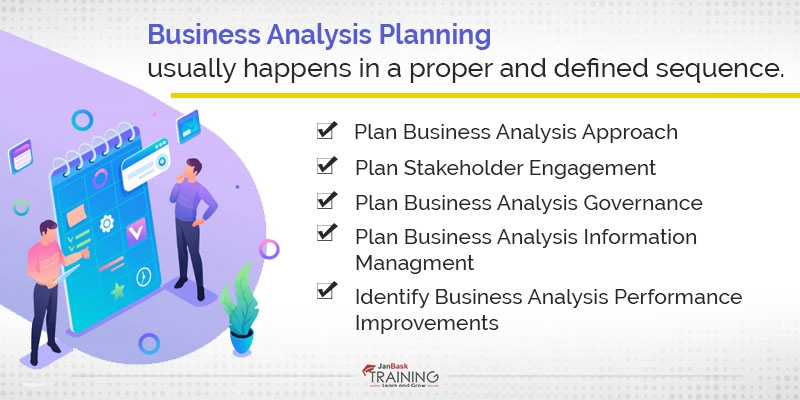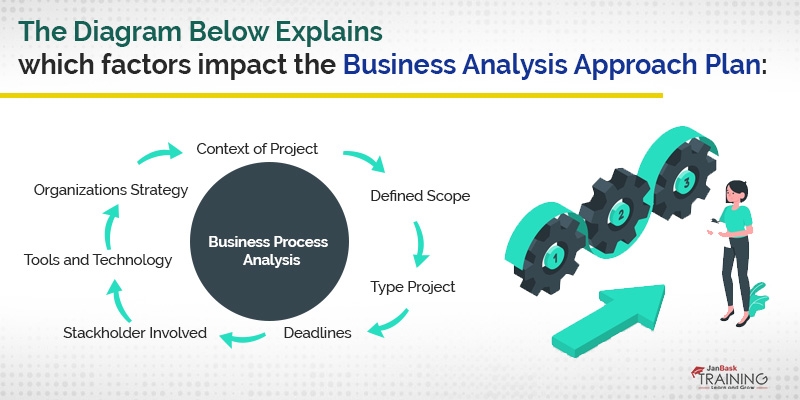20
DecChristmas Offer : Get Flat 35% OFF on Live Classes + $999 Worth of Study Material FREE! - SCHEDULE CALL
Business Analysis Planning helps us to identify tasks that need to be completed for business analysis. Business Analyst needs the information to identify stakeholders, define roles and responsibilities, develop estimation, plan communication, and determine deliverables. All these form the basis of the analysis plan.
Business Analysis Plan is developed by a business analyst with the help of Project members in the waterfall model or Scrum team in agile methodology respectively. Business Analysis Planning usually happens in a proper and defined sequence.

This blog will help to give in-depth knowledge on the following topics of business analysis
The business analysis approach is a method that every business analyst has to think of during the initiation of the project. It is the first plan that the business analyst put up to start up any new requirement. Whenever a new task comes in front of the business analyst the first step is to determine which approach should be taken?
Read More: Business Analysis Tutorial guide
Every project shows up multiple challenges, certain pain areas for customers or internal people with some expected results and solutions.
The business analyst or the senior-most business analyst has to come up with a plan to solve all these questions which have been put up. This plan is nothing but an approach to analytical thinking to get work done effectively and comprehensively.
The purpose of the business analysis approach plan is to set out expectations out of the analysis being performed and put them across various stakeholders. A strong business analysis approach forms the pillars for proper requirements and development. This plan should have a clear indication as to how the business analysis approach would impact the execution of the project.
These are the sequential pattern to plan business analysis -
Business Analysis Approach Plan has seen a vast change in recent years. Earlier everything was aligned as per waterfall methodology, but with Agile into the industry, it has become much easier to put the approach plan. Business Analysis Approach plan involves revolving around the User-stories which are added in JIRA. This approach is helping the business analysts to put forth their plan in much more aligned fashion. The plan is integrated with development, testing, and sign-off, thus being in congruence with the result.
Read: Understand The Background Of Agile Business Analysis - BA In Agile, Role & Responsibility
Read More: How to Get a Business Analyst Job?
Depending upon the organization, the business analysis approach plan can be a formal document or an ad-hoc analysis plan, but both being an agreed mode of operation. By any means, this approach plan should be aligned with the way an organization thinks and operates its line of business. The diagram below explains which factors impact the business analysis approach plan:

What do you think is more difficult - Working on information or Working with People?
Working with people can be simple as well as very challenging. So who are these people? - These people are formally called Stakeholders. Stakeholders are key people who would get impacted in any possible way by business projects.
Having a formal and documented stakeholder engagement plan is important for successful business analysis.
Imagine a situation where none of the stakeholders are being engaged. Who would pay attention to the analysis being done for the project? Who all would be distributed various responsibilities? Who all would be held accountable?
The answer lies in having Stakeholders and the process to engage them.
Engaging stakeholders helps to align with the project, distributing their responsibilities and resolving communication gaps among each one of them.
The stakeholder engagement plan needs to be detailed down in the form of strategic and formal documents. Let’s see details which need to be captured in stakeholder engagement plan -
The below steps shows the way to start the stakeholder engagement plan -

Read: Understanding The Background Of Business Process Re-engineering
Business Analysis Governance defines the components of business analysts which are being used to support the governance functions of any organizations. The goal of this plan is to state how decisions are made about requirements and design which include documentation, reviews, approval, and prioritization.
The below processes needs to be followed while planning business analysis governance -
There are four primary focus areas of Business Analysis Governance Plan -
Business Analysis Governance Plan applies and holds good to all principles be it agile or waterfall. However, the process for the governance plan is more in the waterfall model. The reason is that in the waterfall methodology, there is a clear decision-making process and accountability for the decisions taken. In agile, the importance is given to the Product Owners, and they are being treated as the decision-makers.
Business Analysis Governance Plan is very much used in Change Management. Change Management requires all of its decisions to be passed via the Change Advisory Board. It follows strict rules and regulations as per the organization’s governance. Any change ticket normally called “CR” needs to be approved by CAB members and moved in the name of Change Manager. But then the aspect which needs to be kept in mind is that all these change tickets need to have a business justification with a strong analysis behind them. Change Management is part of the change control process where data has to be systematically and sequentially captured.
Let’s understand some key concepts in planning business analysis governance -
What can be inputs for this?
What are the important elements of this plan?
What would be important guidelines for this plan?
The result of all the above key concepts would be the appropriate Governance Plan.
Read: The Ultimate Guide to Interaction Overview Diagram
Business analysis requires immense effort and knowledge to improve the performance, quality, and future of any business project. But then don’t you think all this hard work needs to be stored and managed efficiently. Business Analysis Information Management Plan identifies how the analysis details are captured, stored and maintained. It should have all the level of details required and stakeholders responsible for each element.
The Business Analysis Information Management helps for the following -
The business analysis information can be stored in multiple ways, but all should be in written format. The business analysis information is documented usually in a word document. With agile in the industry it is then moved to Confluence for everyone’s reference. Whenever these analyses are passed externally, they are in PDF format so that it does not get changed without impacting the original content. Business Analysis information can also be stored in excel if it deals with a large amount of data.
Read More: What Does a Business Analyst Do?
Thus, it is important to understand that information management needs to be carefully done for all the business analysis and it should be as per the plan.
Conclusion
In a nutshell, Business Analysis Plan is a central document that defines the basis of all project work. It’s important to understand that before jumping over to any project development and implementation a deep analysis is required. That’s exactly what business analysis planning is being for any business projects.
I hope the above content would have helped you to take a deep dive into business analysis planning.
The words of Abraham Lincoln suits this context as -
“Give me six hours to chop down a tree and I will spend first four sharpening the axe”
Read: Understand The Background Of Business Analysis Documentation Now
 Pinterest
Pinterest
 Email
Email
I believe in knowledge sharing and bringing change in people's lives. As a business analyst by profession, I love to explore everything about the way businesses should drive. I keep in touch with the latest business analysis updates.

Cyber Security

QA

Salesforce

Business Analyst

MS SQL Server

Data Science

DevOps

Hadoop

Python

Artificial Intelligence

Machine Learning

Tableau
Search Posts
Related Posts
Top 11 Business Analyst Skills Every BA Should Know About!
![]() 12.7k
12.7k
What is the Future Career Path and Scope of Business Analyst
![]() 211.9k
211.9k
Top 100 Business Analyst Interview Questions And Answers
![]() 194.5k
194.5k
Business Analyst vs Financial Analyst
![]() 132k
132k
Understand The Background Of Agile Business Analysis - BA In Agile, Role & Responsibility
![]() 5.6k
5.6k
Receive Latest Materials and Offers on Business Analyst Course
Interviews